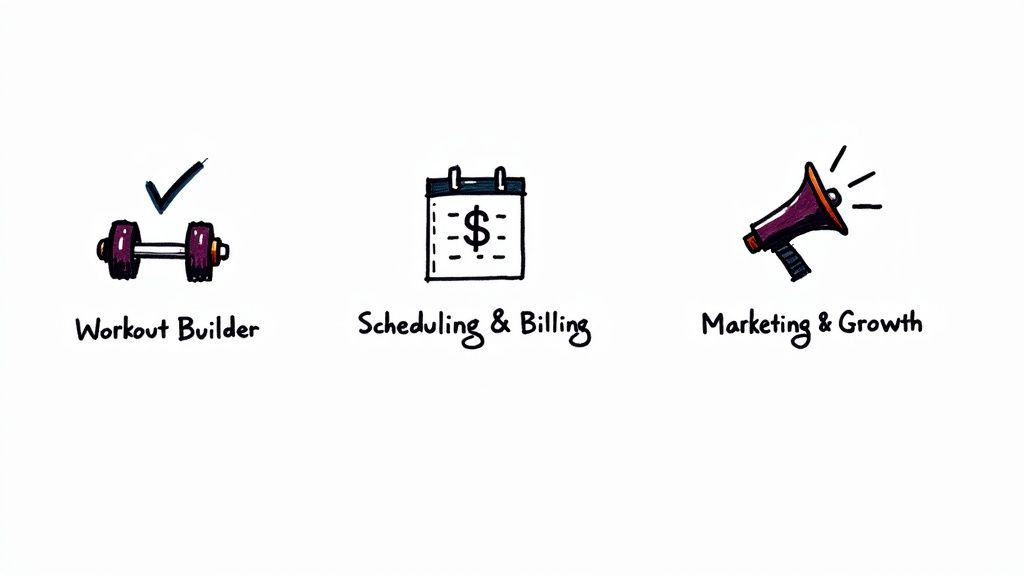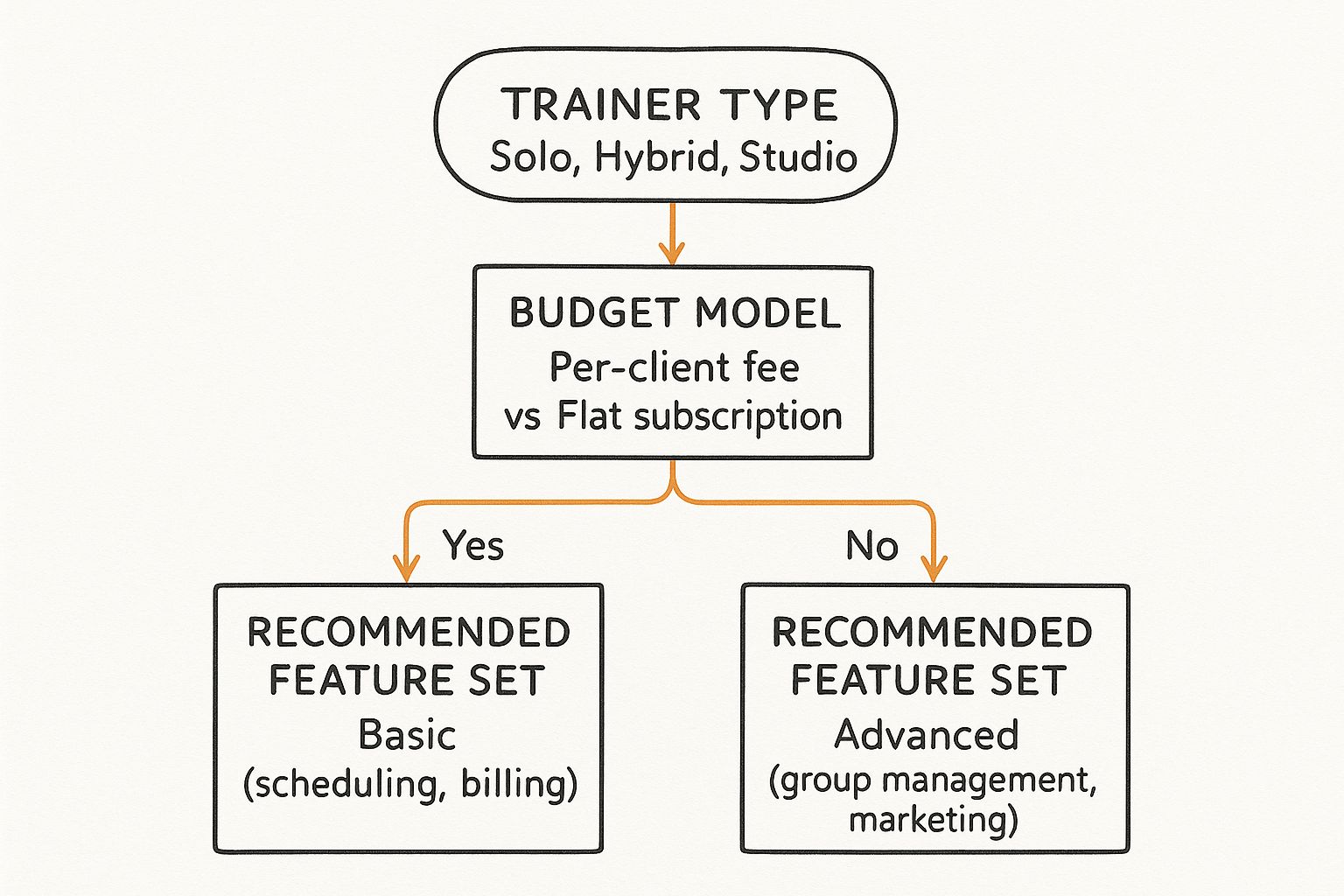Find the best personal training client management software to grow your gym. Get expert tips on choosing the right platform today!
This article is proposed by Gymkee, the personal trainer software that allows you to deliver the best coaching experience to your clients while saving time and growing your personal training business.
Try Gymkee for free for 14 daysIf you're still using spreadsheets, WhatsApp, and notebooks to manage clients, you're not just disorganized—you're limiting your business's growth. The right personal training client management software isn't an upgrade; it's a fundamental shift from being just a trainer to running a scalable fitness business.

Let's be direct. A system built on static documents creates friction. Every manual update to a Google Sheet, every workout sent via text, every payment reminder you type—that's time you could spend coaching, prospecting, or working on your business.
This manual process does more than waste time; it makes you look unprofessional. Clients today expect a seamless digital experience. When they have to search through old emails for a workout or log progress in a clunky spreadsheet, their engagement drops. When engagement drops, so does accountability and retention.
Switching to dedicated software isn't just about clawing back a few hours a week. It's about building a client experience that justifies your rates and opens up new revenue streams.
A professional platform delivers tangible results:
The core benefit isn't just automation; it's reducing client churn. A high-touch, engaging digital experience makes your service sticky. It becomes an invaluable part of their fitness journey that a spreadsheet can never replicate.
The personal training market is expanding. According to a 2021 IBISWorld report, there are around 728,000 personal training businesses globally, with the market growing at a 4.8% annualized rate since 2016. To compete, you need tools that streamline your workflow and allow you to manage a growing client list efficiently.

Not all personal training client management software is created equal. The features one coach relies on might be useless to you. Your choice should be dictated by how you coach.
Instead of getting lost in feature lists, focus on what you actually need. We can separate this into two categories: tools that improve your client's experience and tools that handle your business administration. This isn't about finding the software with the most features. It's about finding the one with the right features for you.
This is about delivering a premium, interactive service that keeps clients accountable. Generic PDFs and random text messages feel cheap and unprofessional.
Here are the tools that make the biggest difference:
These are the features that give you your time back. They automate administrative tasks so you can focus on coaching.
The goal is to automate the administrative noise so you can focus on what you do best: coaching. A seamless backend makes for a much smoother front-end experience for your clients.
For example, trainers who focus on specific niches, like strength and conditioning, might use specialized lifting and fitness software like Liftosaur. It offers advanced programming and tracking that a general-purpose app may lack. This demonstrates how your coaching style should drive your software choice.
Ultimately, your toolkit must include scheduling with automated reminders and integrated payment processing. These are non-negotiable. They reduce no-shows and eliminate awkward conversations about late payments.
This table separates the absolute must-haves from features that are great but not critical right away. Use this to evaluate any platform you're considering.
This breakdown should help you prioritize. Nail the "must-haves" first. You can always look for the "nice-to-haves" as your business grows.
Choosing the right personal training client management software should be a practical decision based on your business now—not where you want it to be in five years. Your immediate needs drive the choice.
Are you a solo online coach, a hybrid trainer, or running a studio with multiple trainers? A solo coach needs a slick mobile app and simple billing. A studio needs staff management and advanced reporting.
Before looking at features, define your budget. Most software uses one of two pricing models: a flat monthly subscription or a fee per client.
Flat fees are predictable and good for coaches with a stable or growing client base. Per-client pricing can be cheaper when you're starting out but can become expensive as you scale.
This infographic breaks down how your business model influences the features you should prioritize.

As you can see, your operational scale—from solo coach to studio—is the main factor that dictates whether a basic or advanced feature set is necessary right now.
Don't rely on polished demo videos. The real test is using the software yourself.
Use free trials to add a few test clients and build a sample program. This is where you'll discover the small frustrations or efficient workflows that demos don't show. When researching, it’s also smart to explore lead management software options for small businesses that can connect your sales funnel to your client delivery.
During a live demo, ask specific, action-oriented questions. "Show me exactly how I can automate weekly check-in reminders," or "Walk me through creating and selling a group program from scratch."
This proactive approach is essential. According to Precedence Research, the Fitness & Wellness Software industry was valued at USD 81.90 billion in 2022 and is projected to hit USD 133.70 billion by 2030, driven by the rise of hybrid fitness models. Choosing the right software positions you to capitalize on this growth. To learn more about different tools, check out our guide on online personal training platforms.
Signing up for new personal training client management software is easy. The real work is setting it up so that your clients actually use it. Your first few actions are critical, so complete these tasks before inviting your first client.
Import your existing client data immediately. Most platforms allow you to upload a CSV file. Before you do, clean up your spreadsheet—correct name spellings, update contact info, and organize your notes. This prep work will prevent future headaches.
Next, brand the platform with your logo and colors to make it feel like your own. Finally, connect your payment gateway immediately to avoid disrupting your cash flow.
The goal is to get your clients on board without it feeling like a chore. Frame the switch as a benefit for them. Use simple, benefit-focused language in your announcement:
For a deeper dive, review these client onboarding best practices to create a welcome experience that sticks.
Don't launch to everyone at once. Start with a small group of your most tech-savvy clients. Let them test the platform and provide honest feedback. This lets you fix any issues in a low-stakes environment before a full rollout.

Buying personal training client management software is the first step. Turning it into a growth engine for your business is what matters. The goal is to make the tool work for you, freeing you up to focus on your clients.
Stop building every program from scratch. Create foundational templates for common goals like fat loss, hypertrophy, or strength. From there, you can build a personalized weekly plan in minutes by tweaking variables for each client. This is how top coaches manage large rosters without burning out.
Put your client communication on autopilot, strategically. Use automated messaging to celebrate wins. An automated high-five when a client hits a PR or finishes their first month can boost morale and build loyalty.
You can also schedule automated check-ins to ask for weekly feedback. This keeps clients engaged and gives you valuable insight without you having to manually follow up with everyone.
Your software is a data goldmine. Use it. Dig into the analytics to see which clients are most compliant and which programs deliver the best results. This data helps you make smarter business decisions, from refining your offers to doubling down on what works.
The key takeaway is simple: Automate the administrative grind so you can personalize the human connection. That’s how you scale your impact and your income.
The market reflects this trend. The global personal training software market was valued at USD 2.1 billion in 2023 and is projected to reach USD 3 billion by 2035, according to Research Nester. This growth is driven by a global focus on tech-enabled health solutions. You can read the full research on this growing market to better understand the trends.
Here are straightforward answers to the most common questions from trainers choosing software.
Prices vary, but expect to pay between $20 to $150+ a month. Cheaper plans (under $40) often cap your number of active clients, which is fine when starting out but becomes limiting as you grow.
For most independent trainers, the sweet spot is the $40-$80 range. This typically gets you unlimited clients, automated billing, and a solid workout builder without paying for enterprise features you won't use. Pricier plans are usually for studios that need multi-staff management and advanced business reporting.
One last tip: always ask about payment processing fees, as they can be a hidden cost.
Client adoption depends on two things: how easy the app is to use and how you introduce it.
First, pick a platform with a clean, simple client app. An overly complicated interface is the fastest way to kill engagement.
Second, frame the new system as a major upgrade for them. Talk about 24/7 program access, real-time progress tracking, and direct messaging. A quick walkthrough during your next session is the single best way to ensure they understand and start using it.
The key is making it feel like an upgrade to their experience, not just another task. A good app should make their fitness journey easier.
Technically, yes, but it can be a major hassle. This is why it's important to choose wisely the first time.
Before you commit to any personal training client management software, ask about their data export policy. This is non-negotiable.
You must be able to easily download all your client data—contact info, workout history, progress photos—in a universal format like CSV. If a company can't confirm this, walk away. This ensures you are never held hostage by their platform and can move your business if you need to.
Ready to stop juggling spreadsheets and give your clients the professional experience they deserve? Gymkee provides all the tools you need to build programs, manage clients, and grow your coaching business in one place. Start your 14-day free trial today.
This article is proposed by Gymkee, the personal trainer software that allows you to deliver the best coaching experience to your clients while saving time and growing your personal training business.
Try Gymkee free for 14 days